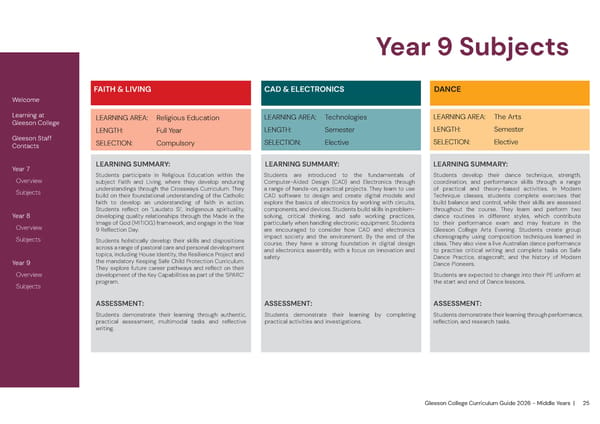Gleeson College Curriculum Guide 2026 - Middle Years | 25 Year 9 Subjects Welcome Learning at Gleeson College Gleeson Staff Contacts Year 7 Overview Subjects Year 8 Overview Subjects Year 9 Overview Subjects LEARNING SUMMARY: Students participate in Religious Education within the subject Faith and Living, where they develop enduring understandings through the Crossways Curriculum. They build on their foundational understanding of the Catholic faith to develop an understanding of faith in action. Students reflect on ‘Laudato Si’, indigenous spirituality, developing quality relationships through the Made in the Image of God (MITIOG) framework, and engage in the Year 9 Reflection Day. Students holistically develop their skills and dispositions across a range of pastoral care and personal development topics, including House Identity, the Resilience Project and the mandatory Keeping Safe Child Protection Curriculum. They explore future career pathways and reflect on their development of the Key Capabilities as part of the ‘SPARC’ program. ASSESSMENT: Students demonstrate their learning through authentic, practical assessment, multimodal tasks and reflective writing. FAITH & LIVING LEARNING AREA: Religious Education LENGTH: Full Year SELECTION: Compulsory DANCE LEARNING AREA: The Arts LENGTH: Semester SELECTION: Elective LEARNING SUMMARY: Students develop their dance technique, strength, coordination, and performance skills through a range of practical and theory-based activities. In Modern Technique classes, students complete exercises that build balance and control, while their skills are assessed throughout the course. They learn and perform two dance routines in different styles, which contribute to their performance exam and may feature in the Gleeson College Arts Evening. Students create group choreography using composition techniques learned in class. They also view a live Australian dance performance to practise critical writing and complete tasks on Safe Dance Practice, stagecraft, and the history of Modern Dance Pioneers. Students are expected to change into their PE uniform at the start and end of Dance lessons. ASSESSMENT: Students demonstrate their learning through performance, reflection, and research tasks. CAD & ELECTRONICS LEARNING AREA: Technologies LENGTH: Semester SELECTION: Elective LEARNING SUMMARY: Students are introduced to the fundamentals of Computer-Aided Design (CAD) and Electronics through a range of hands-on, practical projects. They learn to use CAD software to design and create digital models and explore the basics of electronics by working with circuits, components, and devices. Students build skills in problem- solving, critical thinking, and safe working practices, particularly when handling electronic equipment. Students are encouraged to consider how CAD and electronics impact society and the environment. By the end of the course, they have a strong foundation in digital design and electronics assembly, with a focus on innovation and safety. ASSESSMENT: Students demonstrate their learning by completing practical activities and investigations.
 2026 Gleeson College Middle Years Curriculum Guide Page 24 Page 26
2026 Gleeson College Middle Years Curriculum Guide Page 24 Page 26